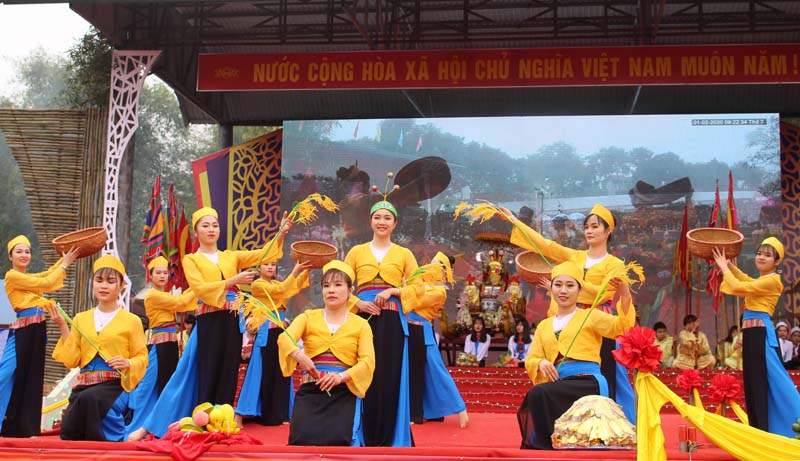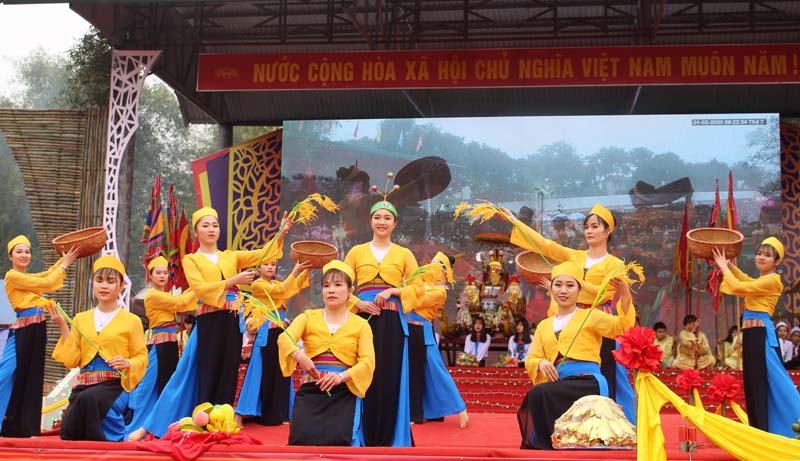
(HBO) - The melody of Vi and Doi singing, lullabies, Thuong Rang and Bo Meng singing is now resounding, spreading along with the renewal of life throughout the villages of Muong Bi. They sing not only on the occasions of festivals, and cultural and artistic exchanges, Muong folk songs are becoming more and more popular through the lullabies, when men and women declaring their love to each other, Sac Bua singing in the festivals of early spring, Thuong Rang singing when working in the fields and gardens...
 The folk song is a special spiritual dish,
which is indispensable in the activities of the Khai Ha Festival in Muong Bi in
2020.
The folk song is a special spiritual dish,
which is indispensable in the activities of the Khai Ha Festival in Muong Bi in
2020.
In recent years, along with preserving the
cultural identity of Muong ethnic people in general, they have also paid
attention to keeping and developing Muong folk songs.
In 2019, together with 2 classes teaching
gong lessons for about 60 learners, the district opened a class with the
participation of 30 people from the district's highland hamlets and communes to
teach Muong folk songs in Chien hamlet, Van Son commune. According to the artist
Bui Thi Mien in Phong Phu commune, who directly teaches folk songs, the study
is increasingly attracting people of different ages.
Many elderly people also want to
participate and follow up to deepen the melodies of the nation and the
homeland. In particular, after each course, the learners can promote the
knowledge and skills they learned to bring the folk songs closer to life,
improving the quality of cultural and artistic movements at the grassroots
level and the enjoyment of the spiritual culture of the people.
In addition to the artisan Bui Thi Mien,
there are dozens of knowledgeable and dedicated artisans in the district,
contributing to conserving and preserving folk songs.
In recent years, the awareness of the value
of Muong folk in particular and the cultural identity of Muong ethnic people in
general have been aroused in the community. In 2017, the first club preserving
the national cultural identity was launched in Ngoi hamlet, Suoi Hoa commune.
In 2019, another more club preserving the national cultural identity was
established in Dinh hamlet, Man Duc town. The clubs have been promoting gong
teaching, folk tunes, folk dances, Doi singing, Thuong Rang and Bo Meng
singing, and maintaining the costumes of the ethnic people, preserving their
identities through spoken words.
Determining not to let Muong folk songs
fade away, the district has focused on other practical and specific solutions
such as coordinating with the Department of Education and Training to open the
classes teaching folk songs within the students' extra-curricular activities.
Thereby, they have helped them understand the value of folk songs and
consciously preserve folk songs. They have been organizing the festive
activities to enrich the cultural and spiritual life of the people as well as
to introduce the cultural identity to tourists from all directions. They have
also regularly been organizing cultural performances and cultural exchanges of
the communal clusters to encourage and evaluate the quality of the mass
cultural and artistic movements. As a result, the folk tunes such as Sac Bua,
Thuong Rang and Bo Meng singing, which have been gradually popularized in the
life of Muong Bi people.
With an increasingly vibrant and widespread emulation movement aimed at building cultured residential areas and cultured families, Yen Thuy District has been making steady progress toward improving both the material and spiritual well-being of its people, while fostering a civilized, prosperous, beautiful, and progressive community.
Once lacking recreational spaces and community facilities, Residential Group 2 in Quynh Lam Ward (Hoa Binh City) has recently received attention for the construction of a new, spacious, and fully equipped cultural house. The project followed the model of state support combined with public contributions in both labor and funding.
The "All people unite to build cultural life" movement, which has been effectively integrated with Kim Boi district’s socio-economic development goals, is fostering a lively spirit of emulation across local residential areas, hamlets, villages, public agencies, and enterprises. In addition, through the initiative, traditional cultural values are being preserved and promoted, while community solidarity and mutual support in poverty reduction and economic development are being strengthened.
A working delegation of the Hoa Binh provincial People’s Committee led by its Permanent Vice Chairman Nguyen Van Toan on June 11 inspected the progress of a project to build the Mo Muong Cultural Heritage Conservation Space linked to tourism services in Hop Phong commune, Cao Phong district.
Born and growing in the heroic land of Muong Dong, Dinh Thi Kieu Dung, a resident in Bo town of Kim Boi district, in her childhood was nurtured by the sweet lullabies of her grandmother and mother. These melodies deeply imprinted on her soul, becoming an inseparable part of her love for her ethnic group's culture. For over 20 years, this love for her hometown has driven Dung to research, collect, and pass down the cultural values of the Muong people to future generations.
In the final days of May, the Ethnic Art Troupe of Hoa Binh Province organized performances to serve the people in remote, mountainous, and particularly disadvantaged areas within the province. These were not just ordinary artistic shows, but they were the meaningful journeys aimed at spreading cultural values, enhancing the spiritual life of the people and contributing to the preservation of ethnic minority cultural identities.



 The folk song is a special spiritual dish,
which is indispensable in the activities of the Khai Ha Festival in Muong Bi in
2020.
The folk song is a special spiritual dish,
which is indispensable in the activities of the Khai Ha Festival in Muong Bi in
2020.